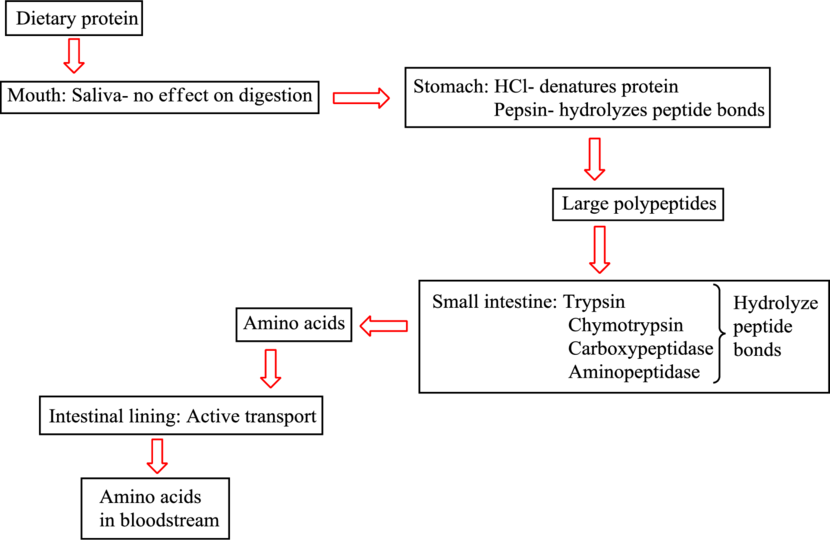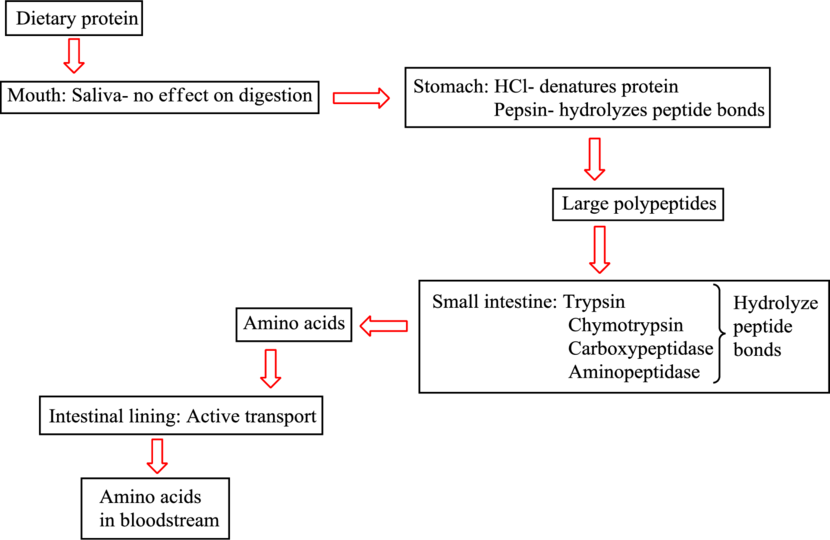
Concept explainers
(a)
Interpretation: To identify whether secretin/hydrochloric acid secretion pairing of term/concept is correct.
Concept introduction: Enzymes are specialized proteins that act as biological catalysts. Enzymes accelerate the biochemical reactions to produce the substances that are needed for cells for their proper functioning. The enzymes are very specific to their action.
Pepsinogen and aminopeptidase are different enzymes involved at different step of the digestion process of dietary protein. The flow chart for protein digestion in the human body is as follows:

(b)
Interpretation: To identify whether hydrochloric acid/pepsinogen activation pairing of term/concept is correct.
Concept introduction: Enzymes are specialized proteins that act as biological catalysts. Enzymes accelerate the biochemical reactions to produce the substances that are needed for cells for their proper functioning. The enzymes are very specific to their action.
Pepsinogen and aminopeptidase are different enzymes involved at different step of the digestion process of dietary protein. The flow chart for protein digestion in the human body is as follows:

(c)
Interpretation: To identify whether bicarbonate ion/proteolytic enzyme pairing of term/concept is correct.
Concept introduction: Enzymes are specialized proteins that act as biological catalysts. Enzymes accelerate the biochemical reactions to produce the substances that are needed for cells for their proper functioning. The enzymes are very specific to their action.
Pepsinogen and aminopeptidase are different enzymes involved at different step of the digestion process of dietary protein. The flow chart for protein digestion in the human body is as follows:

(d)
Interpretation: To identify whether aminopeptidase/pancreatic digestive enzyme pairing of term/concept is correct.
Concept introduction: Enzymes are specialized proteins that act as biological catalysts. Enzymes accelerate the biochemical reactions to produce the substances that are needed for cells for their proper functioning. The enzymes are very specific to their action.
Pepsinogen and aminopeptidase are different enzymes involved at different step of the digestion process of dietary protein.
The flow chart for protein digestion in the human body is as follows:

Want to see the full answer?
Check out a sample textbook solution
Chapter 15 Solutions
Organic And Biological Chemistry
- Is it possible to get a sufficient supply of nutritionally adequate proteins by eating only vegetables?arrow_forwardOne occasionally hears diet advice that proteins and carbohydrates should not be eaten at the same meal. Does this advice make sense to you in light of Figure 28-11?arrow_forwardWhat is an extremophile?arrow_forward
 Organic And Biological ChemistryChemistryISBN:9781305081079Author:STOKER, H. Stephen (howard Stephen)Publisher:Cengage Learning,
Organic And Biological ChemistryChemistryISBN:9781305081079Author:STOKER, H. Stephen (howard Stephen)Publisher:Cengage Learning, General, Organic, and Biological ChemistryChemistryISBN:9781285853918Author:H. Stephen StokerPublisher:Cengage Learning
General, Organic, and Biological ChemistryChemistryISBN:9781285853918Author:H. Stephen StokerPublisher:Cengage Learning Introduction to General, Organic and BiochemistryChemistryISBN:9781285869759Author:Frederick A. Bettelheim, William H. Brown, Mary K. Campbell, Shawn O. Farrell, Omar TorresPublisher:Cengage Learning
Introduction to General, Organic and BiochemistryChemistryISBN:9781285869759Author:Frederick A. Bettelheim, William H. Brown, Mary K. Campbell, Shawn O. Farrell, Omar TorresPublisher:Cengage Learning Chemistry for Today: General, Organic, and Bioche...ChemistryISBN:9781305960060Author:Spencer L. Seager, Michael R. Slabaugh, Maren S. HansenPublisher:Cengage Learning
Chemistry for Today: General, Organic, and Bioche...ChemistryISBN:9781305960060Author:Spencer L. Seager, Michael R. Slabaugh, Maren S. HansenPublisher:Cengage Learning



